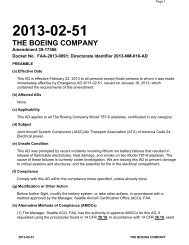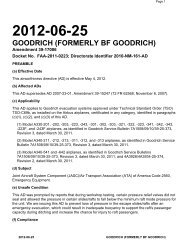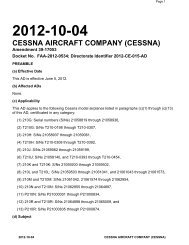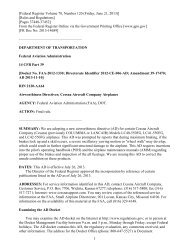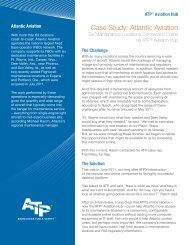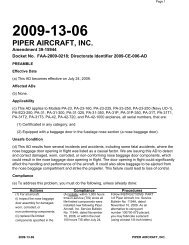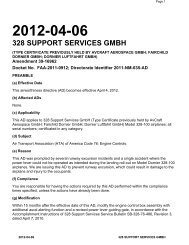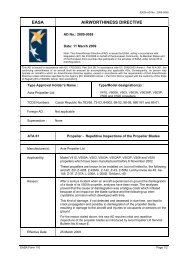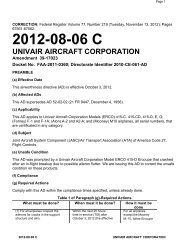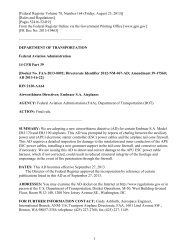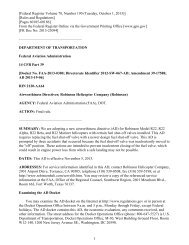2012-11-09
2012-11-09
2012-11-09
Create successful ePaper yourself
Turn your PDF publications into a flip-book with our unique Google optimized e-Paper software.
Page 1<br />
<strong>2012</strong>-<strong>11</strong>-<strong>09</strong><br />
TRANSPORT CATEGORY AIRPLANES<br />
Amendment 39-17072<br />
Docket No. FAA-<strong>2012</strong>-0102; Directorate Identifier <strong>2012</strong>-NM-004-AD<br />
PREAMBLE<br />
(a) Effective Date<br />
This airworthiness directive (AD) is effective August 10, <strong>2012</strong>.<br />
(b) Affected ADs<br />
This AD supersedes AD 20<strong>11</strong>-04-<strong>09</strong>, Amendment 39-16630 (76 FR 12556, March 8, 20<strong>11</strong>).<br />
(c) Applicability<br />
This AD applies to transport category airplanes, in passenger-carrying operations, as specified in<br />
paragraph (c)(1) or (c)(2) of this AD.<br />
(1) Airplanes that are in compliance with the requirements of AD 20<strong>11</strong>-04-<strong>09</strong>, Amendment 39-<br />
16630 (76 FR 12556, March 8, 20<strong>11</strong>).<br />
(2) Airplanes equipped with any chemical oxygen generator installed in any lavatory and are:<br />
(i) Operating under 14 CFR part 121; or<br />
(ii) U.S.-registered and operating under 14 CFR part 129, with a maximum passenger capacity<br />
of 20 or greater.<br />
(d) Subject<br />
Joint Aircraft System Component (JASC)/Air Transport Association (ATA) of America Code 35,<br />
Oxygen.<br />
(e) Unsafe Condition<br />
This AD was prompted by the determination that the current design of chemical oxygen<br />
generators presents a hazard that could jeopardize flight safety. We are issuing this AD to<br />
eliminate this hazard and ensure that all lavatories have a supplemental oxygen supply.<br />
(f) Compliance<br />
Comply with this AD within the compliance times specified, unless already done.<br />
(g) Retained Oxygen Generator<br />
<strong>2012</strong>-<strong>11</strong>-<strong>09</strong> TRANSPORT CATEGORY AIRPLANES
Page 2<br />
This paragraph restates the requirements of paragraph (g) of AD 20<strong>11</strong>-04-<strong>09</strong>, Amendment 39-<br />
16630 (76 FR 12556, March 8, 20<strong>11</strong>). Within 21 days after March 14, 20<strong>11</strong> (the effective date of<br />
AD 20<strong>11</strong>-04-<strong>09</strong>, Amendment 39-16630 (76 FR 12556, March 8, 20<strong>11</strong>)), do the actions specified<br />
in paragraphs (g)(1) and (g)(2) of this AD.<br />
(1) Activate all chemical oxygen generators in the lavatories until the generator oxygen supply is<br />
expended. An operator may also remove the oxygen generator(s), in accordance with existing<br />
maintenance practice, in lieu of activating it.<br />
(2) For each chemical oxygen generator, after the generator is expended (or removed), remove or<br />
re-stow the oxygen masks and close the mask dispenser door.<br />
Note 1 to paragraph (g) of this AD: Design approval holders are not expected to release service<br />
instructions for the action specified in paragraph (g) of this AD.<br />
(h) Retained Information About Hazardous Material<br />
This paragraph restates the information in Note 1 of AD 20<strong>11</strong>-04-<strong>09</strong>, Amendment 39-16630 (76<br />
FR 12556, March 8, 20<strong>11</strong>). Chemical oxygen generators are considered a hazardous material<br />
and subject to specific requirements under Title 49 CFR for shipping. Oxygen generators must be<br />
expended prior to disposal but are considered a hazardous waste; therefore, disposal must be in<br />
accordance with all Federal, State, and local regulations. Expended oxygen generators are<br />
forbidden in air transportation as cargo. For more information, contact 1-800-HMR-4922.<br />
(i) Retained Compliance With Federal Aviation Regulations of AD 20<strong>11</strong>-04-<strong>09</strong>, Amendment 39-<br />
16630 (76 FR 12556, March 8, 20<strong>11</strong>)<br />
This paragraph restates the requirements of paragraph (h) of AD 20<strong>11</strong>-04-<strong>09</strong>, Amendment 39-<br />
16630 (76 FR 12556, March 8, 20<strong>11</strong>). Notwithstanding the requirements of Sections 25.1447,<br />
121.329, 121.333, and 129.13 of the Federal Aviation Regulations (14 CFR 25.1447, 121.329,<br />
121.333, and 129.13), operators complying with this AD are authorized to operate affected<br />
airplanes until accomplishment of the actions specified in paragraph (l) of this AD.<br />
(j) Retained Parts Installation of AD 20<strong>11</strong>-04-<strong>09</strong>, Amendment 39-16630 (76 FR 12556, March 8,<br />
20<strong>11</strong>)<br />
This paragraph restates the requirements of paragraph (i) of AD 20<strong>11</strong>-04-<strong>09</strong>, Amendment 39-<br />
16630 (76 FR 12556, March 8, 20<strong>11</strong>). After March 14, 20<strong>11</strong> (the effective date of AD<br />
20<strong>11</strong>-04-<strong>09</strong>), and until accomplishment of the actions specified in paragraph (l) of this AD, no<br />
person may install a chemical oxygen generator in any lavatory on any affected airplane.<br />
(k) Retained Special Flight Permit of AD 20<strong>11</strong>-04-<strong>09</strong>, Amendment 39-16630 (76 FR 12556,<br />
March 8, 20<strong>11</strong>)<br />
This paragraph restates the requirements of paragraph (j) of AD 20<strong>11</strong>-04-<strong>09</strong>, Amendment 39-<br />
16630 (76 FR 12556, March 8, 20<strong>11</strong>). Special flight permits, as described in Section 21.197 and<br />
Section 21.199 of the Federal Aviation Regulations (14 CFR 21.197 and 21.199), are not allowed<br />
for the accomplishment of the actions specified in paragraph (g) of this AD.<br />
<strong>2012</strong>-<strong>11</strong>-<strong>09</strong> TRANSPORT CATEGORY AIRPLANES
Page 3<br />
(l) New Requirements of This AD: Oxygen System Restoration<br />
Within 37 months after the effective date of this AD, install a supplemental oxygen system that<br />
meets all applicable sections of parts 25 and 121 of the Federal Aviation Regulations (14 CFR<br />
part 25 and 14 CFR part 121) in each lavatory, as specified in paragraph (l)(1) or (l)(2) of this AD,<br />
as applicable.<br />
(1) If compliance with paragraph (l) of this AD is achieved using a chemical oxygen generator, the<br />
actions specified in paragraph (l) of this AD must be done in accordance with a method approved<br />
by the Manager of the responsible FAA oversight office having responsibility over the<br />
modification. For a method to be approved, it must meet the certification basis of the airplane, and<br />
the approval must specifically refer to this AD.<br />
(2) If compliance with paragraph (l) of this AD is achieved without a chemical oxygen generator,<br />
the specifications of paragraphs (l)(2)(i) and (l)(2)(ii) of this AD apply. Any repairs or alterations to<br />
a system installed and approved in accordance with this paragraph may be accomplished in<br />
accordance with 14 CFR part 43, provided the operator's maintenance program contains an<br />
airworthiness limitation that prohibits the installation of chemical oxygen generators in lavatories.<br />
(i) The modification must receive FAA approval in accordance with 14 CFR part 21 as a major<br />
design change. Notwithstanding operations specification restrictions to the contrary,<br />
organizational approval holders may exercise their full authority in approving installations that<br />
meet the installation requirements of this AD.<br />
(ii) Deviation from approved service instructions and subsequent modifications may be handled<br />
by normal operator procedures without requiring approval of an alternative method of<br />
compliance.<br />
(m) Minimum Equipment List (MEL)<br />
Notwithstanding the requirements of 14 CFR 121.628(b)(2) and 14 CFR 129.14, the equipment<br />
required by paragraph (l) of this AD may be included in the Minimum Equipment List, as<br />
applicable.<br />
(n) Alternative Methods of Compliance (AMOCs)<br />
(1) The Manager, Transport Standards Staff, ANM-<strong>11</strong>0, FAA, has the authority to approve<br />
AMOCs for this AD, if requested using the procedures found in 14 CFR 39.19. In accordance with<br />
14 CFR 39.19, send your request to your principal inspector or local Flight Standards District<br />
Office, as appropriate. If sending information directly to the manager of the Transport Standards<br />
Staff, send it to the attention of the person identified in the Related Information section of this AD.<br />
(2) Before using any approved AMOC, notify your appropriate principal inspector, or lacking a<br />
principal inspector, the manager of the local flight standards district office/certificate holding<br />
district office.<br />
(o) Related Information<br />
For more information about this AD, contact Jeff Gardlin, Aerospace Engineer, Airframe and<br />
<strong>2012</strong>-<strong>11</strong>-<strong>09</strong> TRANSPORT CATEGORY AIRPLANES
Page 4<br />
Cabin Safety Branch, ANM-<strong>11</strong>5, FAA, Transport Airplane Directorate, 1601 Lind Avenue SW.,<br />
Renton, Washington 98057-3356; phone: 425-227-2136; fax: 425-227-<strong>11</strong>49; email:<br />
jeff.gardlin@faa.gov.<br />
(p) Material Incorporated by Reference<br />
None.<br />
FOR FURTHER INFORMATION CONTACT: Jeff Gardlin, Aerospace Engineer, Airframe and Cabin<br />
Safety Branch, ANM-<strong>11</strong>5, FAA, Transport Airplane Directorate, 1601 Lind Avenue SW., Renton,<br />
Washington 98057-3356; phone: 425-227-2136; fax: 425-227-<strong>11</strong>49; email: jeff.gardlin@faa.gov.<br />
Issued in Renton, Washington, on May 23, <strong>2012</strong>.<br />
Michael Kaszycki, Acting Manager, Transport Airplane Directorate, Aircraft Certification Service.<br />
<strong>2012</strong>-<strong>11</strong>-<strong>09</strong> TRANSPORT CATEGORY AIRPLANES
[Federal Register Volume 77, Number 123 (Tuesday, June 26, <strong>2012</strong>)]<br />
[Rules and Regulations]<br />
[Pages 38000-38004]<br />
From the Federal Register Online via the Government Printing Office [www.gpo.gov]<br />
[FR Doc No: <strong>2012</strong>-15683]<br />
––––––––––––––––––––––––––––––––––<br />
DEPARTMENT OF TRANSPORTATION<br />
Federal Aviation Administration<br />
14 CFR Part 39<br />
[Docket No. FAA-<strong>2012</strong>-0102; Directorate Identifier <strong>2012</strong>-NM-004-AD; Amendment 39-17072;<br />
AD <strong>2012</strong>-<strong>11</strong>-<strong>09</strong>]<br />
RIN 2120-AA64<br />
Airworthiness Directives; Various Transport Category Airplanes<br />
AGENCY: Federal Aviation Administration (FAA), DOT.<br />
ACTION: Final rule.<br />
––––––––––––––––––––––––––––––––––<br />
SUMMARY: We are superseding an existing airworthiness directive (AD) for certain transport<br />
category airplanes. That AD currently requires either activating all chemical oxygen generators in the<br />
lavatories until the generator oxygen supply is expended, or removing the oxygen generator(s); and,<br />
for each chemical oxygen generator, after the generator is expended (or removed), removing or<br />
restowing the oxygen masks and closing the mask dispenser door. This new AD requires installing a<br />
supplemental oxygen system in affected lavatories, which terminates the requirements of the existing<br />
AD. This AD was prompted by reports that the current design of the oxygen generators presents a<br />
hazard that could jeopardize flight safety. We are issuing this AD to eliminate a hazard that could<br />
jeopardize flight safety, and to ensure that all lavatories have a supplemental oxygen supply.<br />
DATES: This AD is effective August 10, <strong>2012</strong>.<br />
ADDRESSES:<br />
Examining the AD Docket<br />
You may examine the AD docket on the Internet at http://www.regulations.gov; or in person at<br />
the Docket Management Facility between 9 a.m. and 5 p.m., Monday through Friday, except Federal<br />
holidays. The AD docket contains this AD, the regulatory evaluation, any comments received, and<br />
other information. The address for the Docket Office (phone: 800-647-5527) is Document<br />
Management Facility, U.S. Department of Transportation, Docket Operations, M-30, West Building<br />
Ground Floor, Room W12-140, 1200 New Jersey Avenue SE., Washington, DC 20590.<br />
FOR FURTHER INFORMATION CONTACT: Jeff Gardlin, Aerospace Engineer, Airframe and<br />
Cabin Safety Branch, ANM-<strong>11</strong>5, FAA, Transport Airplane Directorate, 1601 Lind Avenue SW.,<br />
1
Renton, Washington 98057-3356; phone: 425-227-2136; fax: 425-227-<strong>11</strong>49; email:<br />
jeff.gardlin@faa.gov.<br />
SUPPLEMENTARY INFORMATION:<br />
Discussion<br />
We issued a notice of proposed rulemaking (NPRM) to amend 14 CFR part 39 to supersede AD<br />
20<strong>11</strong>-04-<strong>09</strong>, Amendment 39-16630 (76 FR 12556, March 8, 20<strong>11</strong>). That AD applies to the specified<br />
products. The NPRM published in the Federal Register on February 27, <strong>2012</strong> (77 FR <strong>11</strong>418). That<br />
NPRM proposed to continue to require either activating all chemical oxygen generators in the<br />
lavatories until the generator oxygen supply is expended, or removing the oxygen generator(s); and,<br />
for each chemical oxygen generator, after the generator is expended (or removed), removing or<br />
restowing the oxygen masks and closing the mask dispenser door. That NPRM also proposed to<br />
require installing a supplemental oxygen system in affected lavatories, which would terminate the<br />
requirements of the existing AD.<br />
Change to NPRM (77 FR <strong>11</strong>418, February 27, <strong>2012</strong>)<br />
We have redesignated Note 1 of the NPRM (77 FR <strong>11</strong>418, February 27, <strong>2012</strong>) as new paragraph<br />
(h) of this AD, reidentified Note 2 as Note 1, and reidentified subsequent paragraphs accordingly.<br />
Comments<br />
We gave the public the opportunity to participate in developing this AD. The following presents<br />
the comments received on the proposal (77 FR <strong>11</strong>418, February 27, <strong>2012</strong>) and the FAA's response to<br />
each comment.<br />
Request To Extend Compliance Time<br />
Airbus, Boeing, Bombardier, Embraer, American Airlines (AA), Delta Air Lines, Southwest<br />
Airlines (SWA), United Airlines (UA), and All Nippon Airways (ANA) requested that we revise the<br />
NPRM (77 FR <strong>11</strong>418, February 27, <strong>2012</strong>) to extend the 24-month compliance time. Airbus, Embraer,<br />
Air Line Pilots Association (ALPA) International, AA, and Boeing noted that the Lavatory Oxygen<br />
Aviation Rulemaking Committee (ARC) chartered on this subject established some notional lifecycle<br />
times from the initiation of a design through a fleet retrofit. The requested compliance time<br />
ranged from 36 to 60 months. The ARC considered even a 4-year compliance time aggressive.<br />
Commenters also noted that there are no actual designs at present; any schedule is at risk until the<br />
design is proven and validated.<br />
We partially agree with the request. Because of the lack of a retrofit design and the magnitude of<br />
the retrofit, and new configuration(s), on such a large number of affected airplanes, we agree that the<br />
proposed compliance time of 24 months is insufficient. We also agree that the ARC's detailed<br />
assessment would not have supported a 24-month compliance time. We disagree, however, to extend<br />
the compliance time to 48 months, or longer. Some of the commenters' concerns, as identified by the<br />
ARC, have been alleviated in the AD (for example, streamlining the compliance process), and it is<br />
clear there are workable design approaches that can be implemented without taking airplanes out of<br />
service. Nonetheless, since no actual designs are yet approved, the retrofit process cannot begin until<br />
a design is approved. We have extended the compliance time in paragraph (l) of this final rule to 37<br />
months after the effective date of the AD.<br />
2
Request To Retain Proposed Compliance Times<br />
The Association of Flight Attendants (AFA) and ALPA encouraged the issuance of the final rule<br />
with the compliance times as proposed. AFA requested that we also incorporate interim measures.<br />
The commenters noted that the total time that lavatories will have been without oxygen would be<br />
about 3.5 years, even with a 24-month compliance time. AFA pointed out that the FAA's assessment<br />
of the safety risk was based on a finite time, and that we originally estimated a two- to four-year<br />
period to restore oxygen. Thus, retaining the proposed 24-month compliance time is appropriate.<br />
With respect to the compliance time, we disagree with the request. Based on the number of<br />
affected airplanes and the lack of a design solution yet approved for any of them, a 24-month<br />
compliance time is not feasible. On the other hand, we acknowledge that compliance will be due later<br />
than the original estimate of a maximum of 4 years. But the adjusted compliance time is still within<br />
the confidence level of the risk assessment–which was conservative–conducted in support of AD<br />
20<strong>11</strong>-04-<strong>09</strong>, Amendment 39-16630 (76 FR 12556, March 8, 20<strong>11</strong>). As explained previously, we have<br />
extended the compliance time to 37 months. With respect to interim measures, we understand the<br />
rationale for the request, and operators may, in fact, elect to employ some interim measures.<br />
However, any interim measures that would be required would take resources away from<br />
implementing the terminating action, and we believe available resources should be directed at<br />
restoring oxygen to the lavatories. We have therefore determined that interim measures should not be<br />
mandated, and that a 37-month compliance time will provide an adequate level of safety.<br />
Request To Delay AD Issuance Pending Service Information Issuance<br />
ANA and AA requested that we delay issuing the AD until service information is available.<br />
ANA stated that, considering lead time for parts and preparation for the modification, the compliance<br />
time should be determined after the service information is released. ANA suggested it would need at<br />
least 36 months for appropriate maintenance planning after the service information is released.<br />
We disagree with the request. Although there are no specific designs available for the affected<br />
airplanes, there are system types in service that will satisfy the requirements of the AD. Airframe<br />
manufacturers and aftermarket modifiers are working on acceptable designs, and we expect that there<br />
will be more than one solution available. The FAA's goal is to retrofit supplemental oxygen systems<br />
as quickly as practical. Waiting for service information would unnecessarily delay that retrofit. We<br />
therefore find it necessary to proceed with issuing this final rule.<br />
Request To Mandate Development of Service Information and Parts<br />
Delta Air Lines requested that we require design approval holders to develop and make available<br />
the necessary modification instructions and hardware. Delta noted that other large-scale retrofit<br />
projects have been complicated by a lack of readily available modification hardware and service<br />
instructions.<br />
We disagree with the request. At this point, the FAA is confident that there will be several<br />
modification options available to operators. All affected airframe manufacturers, as well as oxygen<br />
system suppliers and airplane modifiers, have discussed their intended approaches with the FAA and<br />
appear to have viable solutions. In addition, Section 21.99 of the Federal Aviation Regulations (14<br />
CFR 21.99) already requires design approval holders to make design information available to correct<br />
an unsafe condition. Thus, the additional regulatory burden of tracking and enforcing a design<br />
approval holder requirement is not justified in this case. But if this situation changes, we may<br />
consider additional rulemaking to extend the time to comply with the requirements of the AD. We<br />
have not changed the final rule regarding this issue.<br />
3
Request To Revise Applicability<br />
Boeing requested that we revise the applicability of the NPRM (77 FR <strong>11</strong>418, February 27,<br />
<strong>2012</strong>). Specifically, Boeing requested removing airplanes that have systems without chemical oxygen<br />
generators (COGs) installed in the lavatory, and by limiting the applicability to airplanes modified in<br />
accordance with AD 20<strong>11</strong>-04-<strong>09</strong>, Amendment 39-16630 (76 FR 12556, March 8, 20<strong>11</strong>), those with<br />
COGs not installed per Special Federal Aviation Regulation (SFAR) <strong>11</strong>1, Amendment Nos. 21-94,<br />
25-133, 121-354, and 129-50 (76 FR 12550, March 8, 20<strong>11</strong>), and those with COGs installed in the<br />
lavatory. Since AD 20<strong>11</strong>-04-<strong>09</strong> already proposed to permit installation of non-COG systems using<br />
normally available approval means, Boeing considered the continued tracking of AD compliance for<br />
that type of system unwarranted. Further, Boeing stated there might be confusion as to whether AD<br />
20<strong>11</strong>-04-<strong>09</strong> would apply to any airplane with such a system installed.<br />
We partially agree with the request. We agree that continued tracking of the non-COG<br />
installation as an AD-related action is overly burdensome. Such systems were not the subject of AD<br />
20<strong>11</strong>-04-<strong>09</strong>, Amendment 39-16630 (76 FR 12556, March 8, 20<strong>11</strong>) (which required removal of the<br />
supplemental oxygen). We disagree, however, to change the applicability of this AD, because the AD<br />
already captures the intent of the request in terms of identifying affected airplanes based on whether<br />
they are in compliance with AD 20<strong>11</strong>-04-<strong>09</strong> or have a chemical oxygen generator installed in any<br />
lavatory. An operator wishing to install a COG system at a later date will need to use the alternative<br />
method of compliance (AMOC) process. But we agree that, with appropriate limitations, subsequent<br />
modifications to a non-COG system can be handled under part 43 of the Federal Aviation<br />
Regulations (14 CFR part 43). We have added a provision in paragraph (l)(2) in this final rule that<br />
permits alterations and repairs to an approved non-COG system in accordance with 14 CFR part 43,<br />
provided the operator's maintenance program contains an airworthiness limitation that prohibits the<br />
installation of COGs in lavatories.<br />
Request To Utilize Alternative Oxygen Dosage Measurement<br />
AVOX Systems (AVOX) requested that we build in a streamlined process for oxygen systems<br />
using the blood oxygen saturation level (SaO2) as the means of determining adequate oxygen dosage.<br />
This method will likely result in somewhat smaller oxygen supplies, which will in turn allow the<br />
systems to more easily fit into the existing spaces, with little or no modification.<br />
The regulations characterize oxygen dosage in terms of tracheal partial pressure, an indirect<br />
method of determining adequate oxygen supply. We infer that AVOX requested this because the<br />
FAA has approved SaO2 via equivalent level of safety findings in accordance with Section<br />
21.21(b)(1) of the Federal Aviation Regulations (14 CFR 21.21(b)(1)), but this has required extensive<br />
testing on the part of the applicants to show that the approach meets the intent of the requirements. It<br />
appears that AVOX would like the FAA to use the knowledge gained from those actions to allow<br />
approval of future projects in an expedited manner, without the same level of testing. We agree that,<br />
in this case, use of the SaO2 method can be useful; this method is specifically discussed in FAA<br />
Policy Statement PS ANM-25-04–which was mentioned in the NPRM (77 FR <strong>11</strong>418, February 27,<br />
<strong>2012</strong>) as a possible method of compliance with the requirements of this AD. FAA Policy Statement<br />
PS-ANM-25-04, issued December 21, 20<strong>11</strong> (http://rgl.faa.gov/RegulatoryandGuidanceLibrary/<br />
rgPolicy.nsf/0/06EE1CEFE9804A2F8625796E005C017F?OpenDocument&Highlight=ps-anm-25-<br />
04), is based on the recommendations of an Aviation Rulemaking Committee (ARC) and provides<br />
guidance to applicants that want to begin restoring oxygen to lavatories in advance of rulemaking.<br />
This policy will be used in making approvals of COG installations that will be used to comply with<br />
this AD. The FAA may also propose new airworthiness standards for the safe installations of COGs<br />
using the ARC recommendations. It is not necessary to change the AD because the information that<br />
we can provide is already available in the policy statement. We have not changed the final rule<br />
regarding this issue.<br />
4
Request To Clarify Certain References<br />
Boeing noted that not all regulations affecting a supplemental oxygen system are identified in<br />
paragraph (k) of the NPRM (77 FR <strong>11</strong>418, February 27, <strong>2012</strong>), and could lead operators to conclude<br />
that only the identified paragraphs need to be complied with. Boeing requested that we revise<br />
paragraph (k)(2) of the NPRM to refer to all of part 25 and part 121 (14 CFR part 25 and 14 CFR part<br />
121), rather than specific sections.<br />
We partially agree with the request. We agree that the current listing of rules could be<br />
misinterpreted, because there is already regulatory relief provided, and the listing is not complete.<br />
The listing matches the regulations for which relief was granted, both in AD 20<strong>11</strong>-04-<strong>09</strong>,<br />
Amendment 39-16630 (76 FR 12556, March 8, 20<strong>11</strong>), and Special Federal Aviation Regulation No.<br />
<strong>11</strong>1, Amendment Nos. 21-94, 25-133, 121-354, and 129-50 (76 FR 12550, March 8, 20<strong>11</strong>), and so in<br />
that sense this list is consistent. But to avoid any confusion, we have revised paragraph (l) in this final<br />
rule (which was paragraph (k) in the NPRM (77 FR <strong>11</strong>418, February 27, <strong>2012</strong>)) to refer to ''all<br />
applicable'' regulations. In actual practice, this will not change the compliance requirements, so there<br />
is no additional burden on any operator to comply with the requirements of this AD.<br />
Request To Include Training Requirements<br />
AFA requested that we revise the NPRM (77 FR <strong>11</strong>418, February 27, <strong>2012</strong>) to include additional<br />
requirements that mandate communication and training for crewmembers on the proper procedures to<br />
follow in the event of a rapid decompression before the AD-mandated actions have been<br />
accomplished on the airplane. AFA also recommended that crew members be notified of the progress<br />
of operators toward showing compliance; many operators have already done something similar, but a<br />
number have not.<br />
We disagree with the request. As previously determined, the risks are very low for the time<br />
periods involved. The resources needed to implement AFA's recommended interim steps could be<br />
better used in rapidly incorporating a final design solution. We have not changed the final rule<br />
regarding this issue.<br />
Request To Revise Cost Estimate<br />
Delta Air Lines requested that we revise the cost analysis to be more specific to different airplane<br />
types and system options, and to characterize the costs per lavatory. The current cost estimate is an<br />
average over the entire fleet, and so by definition is not accurate for each affected airplane.<br />
We disagree with the request. The variation in cost per airplane over the fleet is typical of any<br />
cost assessment. While the costs could be presented on a per-lavatory basis, this would also be an<br />
average, and not necessarily correct for any given lavatory. In addition, the cost estimates are based<br />
on the forecasted most cost-effective approach. An operator can use a more expensive approach, but<br />
the cost estimate would not account for that increased cost. We have not changed the final rule<br />
regarding this issue.<br />
Request To Clarify Configuration<br />
ANA noted that paragraph (k) of the NPRM (77 FR <strong>11</strong>418, February 27, <strong>2012</strong>) would allow<br />
operators to choose between two methods of compliance: with or without chemical oxygen<br />
generators. ANA requested that we clarify what configuration will be selected on production<br />
airplanes.<br />
We disagree with the request. The decision on which configuration to use is up to the operators<br />
and their suppliers. The FAA has criteria for either approach, and either is acceptable. We have not<br />
changed the final rule regarding this issue.<br />
5
Request To Clarify Certain AMOC Provisions<br />
AA requested that paragraph (k)(2)(i) of the NPRM (77 FR <strong>11</strong>418, February 27, <strong>2012</strong>) be<br />
revised to include a provision relieving the need for AMOC approval for non-COG installations. AA<br />
interprets the existing provisions as meaning that an AMOC is not required and wants this stated<br />
explicitly.<br />
We disagree with the request. Information regarding AMOCs related to non-COG installations<br />
was provided in paragraph (k)(2)(ii) of the NPRM (77 FR <strong>11</strong>418, February 27, <strong>2012</strong>) and is retained<br />
in this final rule (in redesignated paragraph (l)(2)(ii)). There is therefore no need to change the final<br />
rule regarding this issue.<br />
Request To Standardize Application of Certain Provision<br />
AA supports the provision specified in paragraph (k)(2)(ii) of the NPRM (77 FR <strong>11</strong>418,<br />
February 27, <strong>2012</strong>) (redesignated as paragraph (l)(2)(ii) in this final rule), but is concerned that,<br />
because the provision is unusual, it may not be uniformly applied in the field.<br />
We agree that this is an unusual provision. To that end, we have prepared an Information for<br />
Operators (InFO) bulletin 12LAV to help explain this provision, as well as other outreach measures<br />
to help ensure standardization. We find it is not necessary to change the final rule to provide further<br />
explanation.<br />
Approval Process for Compliance With AD, Using Chemical Oxygen Generators<br />
Because of the issues addressed by AD 20<strong>11</strong>-04-<strong>09</strong>, Amendment 39-16630 (76 FR 12556,<br />
March 8, 20<strong>11</strong>), COG installations will require new considerations in order to be found acceptable as<br />
methods of compliance with this AD. The approval for COG installations will therefore be in a<br />
manner approved by the FAA as discussed below.<br />
Approval Process for Compliance With AD, Using Other Systems<br />
Chemical oxygen generators are one type of system used to provide supplemental oxygen. While<br />
the majority of transport category airplanes use this system in lavatories, there are other systems as<br />
well. If another system type is used to meet this AD, the original unsafe condition is not a concern. In<br />
that case, the means of compliance is straightforward, and we have determined that the approval<br />
method could be more flexible than is usually the case for an AD. For example, delegated<br />
organizations cannot normally make compliance findings for ADs; service information associated<br />
with ADs must be adhered to exactly, or else an AMOC must be approved. For this AD, if the type of<br />
system is other than a COG, then we have determined that these restrictions could be relaxed.<br />
Therefore, paragraph (l)(2) of this AD contains provisions to permit existing approval processes to be<br />
used, as long as the means of compliance is other than a COG. This provision takes precedence over<br />
current limitations in operators' authority to use their organizational delegations when showing<br />
compliance with an AD. In addition, if an operator uses service information that is approved for such<br />
installations, deviations from the service information can be addressed using the operator's normal<br />
procedures without requiring an AMOC.<br />
Oversight Office<br />
Paragraph (l) of this AD refers to the FAA oversight office responsible for approval of<br />
modifications used to show compliance. This will typically be the aircraft certification office having<br />
geographic oversight of the applicant. In the case of service instructions from design approval holders<br />
of other countries, this would be the Transport Standards Staff. We anticipate that modifications to<br />
meet this AD will require either supplemental type certificate or amended type certificate approval.<br />
6
Minimum Equipment List (MEL)<br />
Although there were no comments on this issue, the FAA has identified a potential conflict with<br />
the minimum equipment list provisions of Sections 121.628 and 129.14 of the Federal Aviation<br />
Regulations (14 CFR 121.628 and 14 CFR 129.14). Since any equipment mandated to be operative<br />
by airworthiness directive is excluded from the MEL unless the airworthiness directive specifically<br />
provides such allowance, we have revised this final rule to add a new paragraph (m) to allow the use<br />
of the MEL, as applicable. We have re-identified subsequent paragraphs accordingly.<br />
Conclusion<br />
We reviewed the relevant data, considered the comments received, and determined that air safety<br />
and the public interest require adopting the AD with the changes described previously–and minor<br />
editorial changes. We have determined that these minor changes:<br />
• Are consistent with the intent that was proposed in the NPRM (77 FR <strong>11</strong>418, February 27,<br />
<strong>2012</strong>) for correcting the unsafe condition; and<br />
• Do not add any additional burden upon the public than was already proposed in the NPRM<br />
(77 FR <strong>11</strong>418, February 27, <strong>2012</strong>).<br />
Costs of Compliance<br />
We estimate that this AD affects 5,500 airplanes of U.S. registry. We estimate the following<br />
costs to comply with the actions specified in this AD.<br />
Estimated Costs<br />
Action Labor cost Parts<br />
cost<br />
Activate COG/expend oxygen supply<br />
[actions retained from AD 20<strong>11</strong>-04-<strong>09</strong>,<br />
Amendment 39-16630 (76 FR 12556,<br />
March 8, 20<strong>11</strong>)]<br />
Oxygen system installation (new action)<br />
Authority for This Rulemaking<br />
Up to 2 workhours<br />
X $85<br />
per hour = up<br />
to $170<br />
24 work-hours<br />
X $85 per hour<br />
= $2,040<br />
Cost per<br />
product<br />
$0 Up to<br />
$170<br />
Cost on U.S.<br />
operators<br />
Up to<br />
$935,000<br />
$6,000 $8,040 $44,220,000<br />
Title 49 of the United States Code specifies the FAA's authority to issue rules on aviation safety.<br />
Subtitle I, Section 106, describes the authority of the FAA Administrator. Subtitle VII, Aviation<br />
Programs, describes in more detail the scope of the Agency's authority.<br />
We are issuing this rulemaking under the authority described in Subtitle VII, Part A, Subpart III,<br />
Section 44701, ''General requirements.'' Under that section, Congress charges the FAA with<br />
promoting safe flight of civil aircraft in air commerce by prescribing regulations for practices,<br />
methods, and procedures the Administrator finds necessary for safety in air commerce. This<br />
regulation is within the scope of that authority because it addresses an unsafe condition that is likely<br />
to exist or develop on products identified in this rulemaking action.<br />
7
Regulatory Findings<br />
We have determined that this AD will not have federalism implications under Executive Order<br />
13132. This AD will not have a substantial direct effect on the States, on the relationship between the<br />
national government and the States, or on the distribution of power and responsibilities among the<br />
various levels of government.<br />
For the reasons discussed above, I certify that this AD:<br />
(1) Is not a ''significant regulatory action'' under Executive Order 12866,<br />
(2) Is not a ''significant rule'' under DOT Regulatory Policies and Procedures (44 FR <strong>11</strong>034,<br />
February 26, 1979),<br />
(3) Will not affect intrastate aviation in Alaska, and<br />
(4) Will not have a significant economic impact, positive or negative, on a substantial number of<br />
small entities under the criteria of the Regulatory Flexibility Act.<br />
List of Subjects in 14 CFR Part 39<br />
Air transportation, Aircraft, Aviation safety, Incorporation by reference, Safety.<br />
Adoption of the Amendment<br />
Accordingly, under the authority delegated to me by the Administrator, the FAA amends 14 CFR<br />
part 39 as follows:<br />
PART 39–AIRWORTHINESS DIRECTIVES<br />
1. The authority citation for part 39 continues to read as follows:<br />
Authority: 49 U.S.C. 106(g), 40<strong>11</strong>3, 44701.<br />
§ 39.13 [Amended]<br />
2. The FAA amends § 39.13 by removing airworthiness directive (AD) 20<strong>11</strong>-04-<strong>09</strong>, Amendment 39-<br />
16630 (76 FR 12556, March 8, 20<strong>11</strong>, and adding the following new AD:<br />
8



